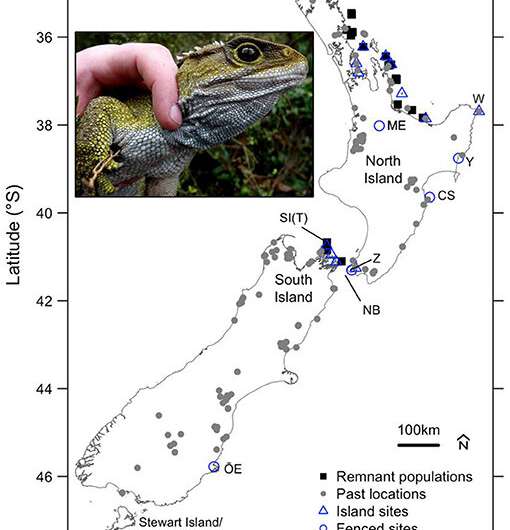Study: Trail-blazing developments in conservation management

Many of us enjoy the familiar surroundings of home, but what if we needed to move to a strange place for our survival?
A University of Otago study has investigated conservation translocation strategies for two of New Zealand's taonga species—tuatara and takahē – to address issues of such environmental novelty.
Published in Frontiers in Conservation Science, the study highlights the risks and rewards of translocations and produced a strategic framework for translocation strategies.
Lead author James Hunter-Ayad, Ph.D. candidate in the Department of Zoology, says it is becoming increasingly challenging to protect the natural world in the face of human-driven environmental changes.
"Conservationists need to make difficult decisions to find the best ways to protect our natural resources, and to have the best chance of making the right calls, it is essential that ecological evidence is considered in the decision-making process.
"Through this study, we developed a framework to help in applying this evidence-based conservation approach to address difficult decisions around how to relocate species for conservation benefit," he says.
The researchers came up with two translocation strategies to manage novelty and any resulting uncertainty for the animals.
Termed "conservative" and "extrapolative" and operating on a spectrum, conservative strategies avoid and remove novel conditions as much as possible, while extrapolative strategies are more experimental, allowing exposure to novel conditions and monitoring outcomes to increase understanding of a species' ecology.
"As each strategy carries specific risks and opportunities, they will be applicable in different scenarios. Extrapolative strategies suit species in recovery which can afford some experimental management, or species facing novel and emerging threats which require less traditional translocations, such as assisted colonisations," Hunter-Ayad says.
Working with the Department of Conservation, the researchers applied their framework to tuatara and takahē – two species with long histories of translocation management.
Using these species as case-studies illustrated how the respective strategies can be put into practice. In this way, these two iconic New Zealand native species are the posterchildren for strategic advances that may benefit the conservation of numerous species around the globe.
Hunter-Ayad says any species relocations need to be considered carefully and targeted to specific circumstances.
"Unifying principles can be applied through the application of a consistent framework when approaching these decisions, which should help to ensure that the best outcomes are achieved."
He describes the developments as "trail-blazing" in conservation management.
"The advances in conservation theory and practice in Aotearoa New Zealand have the potential to translate into improvements in the management of threatened species around the world.
"We expect a conservative-extrapolative framework will have increasing relevance as conservation practice is developing away from traditional, preservationist approaches, so-called 'fortress' conservation, towards goals with increasing ambition and scope to include ecosystem services, ecological restoration, and rewilding as key objectives."
More information: James Hunter-Ayad et al, Novel Conditions in Conservation Translocations: A Conservative-Extrapolative Strategic Framework, Frontiers in Conservation Science (2021). DOI: 10.3389/fcosc.2021.691714
Provided by University of Otago


















